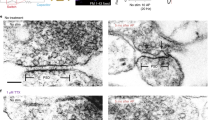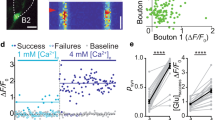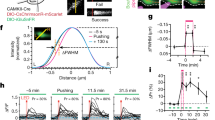Abstract
Ribbon-type synapses in inner hair cells of the mammalian cochlea encode the complexity of auditory signals by fast and tonic release through fusion of neurotransmitter-containing vesicles. At any instant, only about 100 vesicles are tethered to the synaptic ribbon, and about 14 of these are docked to the plasma membrane1,2, constituting the readily releasable pool3. Although this pool contains about the same number of vesicles as that of conventional synapses4,5, ribbon release sites operate at rates of about two orders of magnitude higher3,6,7 and with submillisecond precision8,9,10,11. How these sites replenish their vesicles so efficiently remains unclear3,12,13. We show here, using two-photon imaging of single release sites in the intact cochlea, that preformed vesicles derived from cytoplasmic vesicle-generating compartments14 participate in fast release and replenishment. Vesicles were released at a maximal initial rate of 3 per millisecond during a depolarizing pulse, and were replenished at a rate of 1.9 per millisecond. We propose that such rapid resupply of vesicles enables temporally precise and sustained release rates. This may explain how the first auditory synapse can encode with indefatigable precision without having to rely on the slow, local endocytic vesicle cycle7.
This is a preview of subscription content, access via your institution
Access options
Subscribe to this journal
Receive 51 print issues and online access
$199.00 per year
only $3.90 per issue
Buy this article
- Purchase on Springer Link
- Instant access to full article PDF
Prices may be subject to local taxes which are calculated during checkout




Similar content being viewed by others
References
Liberman, M. C. Efferent synapses in the inner hair cell area of the cat cochlea: an electron microscopic study of serial sections. Hear. Res. 3, 189–204 (1980)
Saito, K. Fine structure of the sensory epithelium of the guinea pig organ of Corti: afferent and efferent synapses of hair cells. J. Ultrastruct. Res. 71, 222–232 (1980)
Moser, T. & Beutner, D. Kinetics of exocytosis and endocytosis at the cochlear inner hair cell afferent synapse of the mouse. Proc. Natl Acad. Sci. USA 97, 883–888 (2000)
Schikorski, T. & Stevens, C. F. Quantitative ultrastructural analysis of hippocampal excitatory synapses. J. Neurosci. 17, 5858–5867 (1997)
Stevens, C. F. & Wang, Y. Facilitation and depression at single central synapses. Neuron 14, 795–802 (1995)
Rosenmund, C. & Stevens, C. F. Definition of the readily releasable pool of vesicles at hippocampal synapses. Neuron 16, 1197–1207 (1996)
Fernandez-Alfonso, T. & Ryan, T. A. The kinetics of synaptic vesicle pool depletion at CNS synaptic terminals. Neuron 41, 943–953 (2004)
Kiang, Y. Stimulus coding in the auditory nerve and cochlear nucleus. Acta Otolaryngol. (Stockh.) 59, 186–200 (1965)
Johnson, D. H. The relationship between spike rate and synchrony in responses of auditory-nerve fibers to single tones. J. Acoust. Soc. Am. 68, 1115–1122 (1980)
Palmer, A. R. & Russell, I. J. Phase-locking in the cochlear nerve of the guinea-pig and its relation to the receptor potential of inner hair-cells. Hear. Res. 24, 1–15 (1986)
Sewell, W. F. in The Cochlea, Springer Handbook of Auditory Research Vol. 8 (eds Dallos, P., Popper, A. N. & Fay, R. R.) Ch. 9, 503–534 (Springer, New York, 1996)
Eisen, M. D., Spassova, M. & Parsons, T. D. Large releasable pool of synaptic vesicles in chick cochlear hair cells. J. Neurophysiol. 91, 2422–2428 (2004)
Edmonds, B. W., Gregory, F. D. & Schweizer, F. E. Evidence that fast exocytosis can be predominantly mediated by vesicles not docked at active zones in frog saccular hair cells. J. Physiol. (Lond.) 560, 439–450 (2004)
Griesinger, C. B., Richards, C. D. & Ashmore, J. F. FM1-43 reveals membrane recycling in adult inner hair cells of the mammalian cochlea. J. Neurosci. 22, 3939–3952 (2002)
Mammano, F. & Ashmore, J. F. Reverse transduction measured in the isolated cochlea by laser Michelson interferometry. Nature 365, 838–841 (1993)
von Gersdorff, H., Vardi, E., Matthews, G. & Sterling, P. Evidence that vesicles on the synaptic ribbon of bipolar neurons can be rapidly released. Neuron 16, 1221–1227 (1996)
Spicer, S. S., Thomopoulos, G. N. & Schulte, B. A. Novel membranous structures in apical and basal compartments of inner hair cells. J. Comp. Neurol. 409, 424–437 (1999)
Beutner, D., Voets, T., Neher, E. & Moser, T. Calcium dependence of exocytosis and endocytosis at the cochlear inner hair cell afferent synapse. Neuron 29, 681–690 (2001)
Siegel, J. H. & Brownell, W. E. Presynaptic bodies in outer hair cells of the chinchilla organ of Corti. Brain Res. 220, 188–193 (1981)
Slepecky, N. B., Galsky, M. D., Swartzentruber-Martin, H. & Savage, J. Study of afferent nerve terminals and fibers in the gerbil cochlea: distribution by size. Hear. Res. 144, 124–134 (2000)
Smith, C. B. & Betz, W. J. Simultaneous independent measurement of endocytosis and exocytosis. Nature 380, 531–534 (1996)
Neves, G. & Lagnado, L. The kinetics of exocytosis and endocytosis in the synaptic terminal of goldfish retinal bipolar cells. J. Physiol. (Lond.) 515, 181–202 (1999)
von Gersdorff, H. & Matthews, G. Depletion and replenishment of vesicle pools at a ribbon-type synaptic terminal. J. Neurosci. 17, 1919–1927 (1997)
Heidelberger, R., Sterling, P. & Matthews, G. Roles of ATP in depletion and replenishment of the releasable pool of synaptic vesicles. J. Neurophysiol. 88, 98–106 (2002)
Glowatzki, E. & Fuchs, P. A. Transmitter release at the hair cell ribbon synapse. Nature Neurosci. 5, 147–154 (2002)
Lenzi, D., Crum, J., Ellisman, M. H. & Roberts, W. M. Depolarization redistributes synaptic membrane and creates a gradient of vesicles on the synaptic body at a ribbon synapse. Neuron 36, 649–659 (2002)
Parsons, T. D. & Sterling, P. Synaptic ribbon. Conveyor belt or safety belt? Neuron 37, 379–382 (2003)
Zenisek, D., Steyer, J. A. & Almers, W. Transport, capture and exocytosis of single synaptic vesicles at active zones. Nature 406, 849–854 (2000)
Holt, M., Cooke, A., Neef, A. & Lagnado, L. High mobility of vesicles supports continuous exocytosis at a ribbon synapse. Curr. Biol. 14, 173–183 (2004)
Stevens, C. F. & Tsujimoto, T. Estimates for the pool size of releasable quanta at a single central synapse and for the time required to refill the pool. Proc. Natl Acad. Sci. USA 92, 846–849 (1995)
Acknowledgements
This work was supported by the MRC, the Wellcome Trust and a BBSRC Imaging grant to C.D.R. We thank U. Egert for his help with part of the image analysis.
Author information
Authors and Affiliations
Corresponding authors
Ethics declarations
Competing interests
The authors declare that they have no competing financial interests.
Supplementary information
Supplementary Figure S1
Pharmacology of the calcium current in adult IHCs. The currents showed the properties of a Cav1.3 current with the α1D subunit, that is, non-inactivating L-type current. L-type blockers abolished or reduced stimulus-induced destaining of synaptic ribbons in IHCs in situ indicating that destaining represents vesicular release. (PDF 371 kb)
Supplementary Figure S2
Additional examples of synaptic release from ribbon release sites and accretion of labelled vesicles from cytoplasmic pools at release sites after stimulation. (PDF 1334 kb)
Supplementary Video S1
The video sequence shows increase of fluorescence derived from cytoplasm at a single release site following stimulation of the cell with a 50 s long stimulus train at 40 Hz. The fluorescence increase is interpreted as vesicle accretion from preformed labelled cytoplasmic pools. (AVI 17761 kb)
Supplementary Legends
Supplementary Legends to accompany the Supplementary Figures S1 and S2, and Supplementary Video S1 (DOC 23 kb)
Erratum
Erratum regarding incomplete Supplementary Information uploading to Nature's website for this paper. This correction was made on 03 June 2005. (DOC 19 kb)
Rights and permissions
About this article
Cite this article
Griesinger, C., Richards, C. & Ashmore, J. Fast vesicle replenishment allows indefatigable signalling at the first auditory synapse. Nature 435, 212–215 (2005). https://doi.org/10.1038/nature03567
Received:
Accepted:
Published:
Issue Date:
DOI: https://doi.org/10.1038/nature03567
This article is cited by
-
Functional and developmental changes in the inner hair cell ribbon synapses caused by Myosin VI knockout and deafness-inducing point mutation
Cell Death Discovery (2023)
-
In Vivo Ribbon Mobility and Turnover of Ribeye at Zebrafish Hair Cell Synapses
Scientific Reports (2017)
-
Single-Cell Transcriptome Analysis of Developing and Regenerating Spiral Ganglion Neurons
Current Pharmacology Reports (2016)
-
Relating structure and function of inner hair cell ribbon synapses
Cell and Tissue Research (2015)
-
Spontaneous and Partial Repair of Ribbon Synapse in Cochlear Inner Hair Cells After Ototoxic Withdrawal
Molecular Neurobiology (2015)
Comments
By submitting a comment you agree to abide by our Terms and Community Guidelines. If you find something abusive or that does not comply with our terms or guidelines please flag it as inappropriate.



